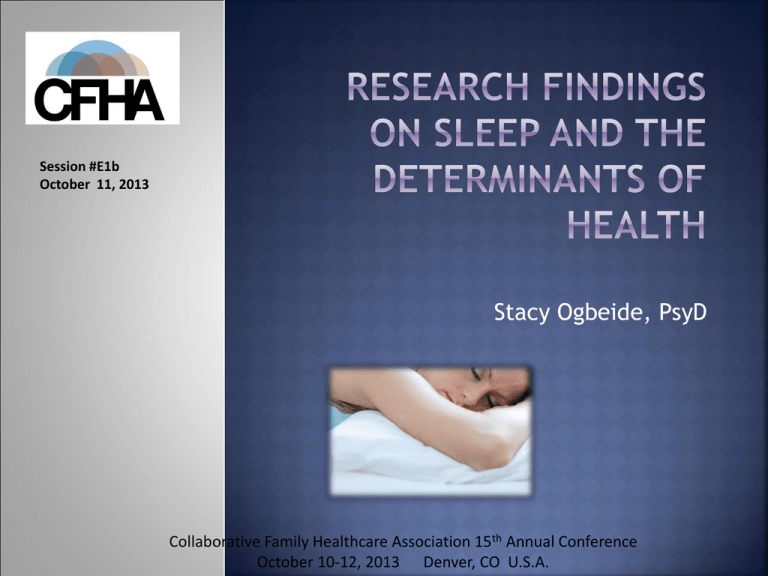determinants of health status beyond objective social status
advertisement

Session #E1b
October 11, 2013
Stacy Ogbeide, PsyD
Collaborative Family Healthcare Association 15th Annual Conference
October 10-12, 2013 Denver, CO U.S.A.
I have not had any relevant financial relationships
during the past 12 months.
Learning
Objective 1: Identify the difference
between subjective social status and
objective social status
Learning Objective 2: Understand the impact
of sleep (duration and quality) on health
status
Learning Objective 3: Understand the benefit
of a subjective measure of social status for
transient medical populations
Socioeconomic status (SES) has been linked to adverse
health outcomes such as cardiovascular disease (CVD)
morbidity and mortality (Ghaed & Gallo, 2007)
Pathways:
Body mass index (BMI), abdominal fat distribution assessed by
waist-hip ratio(WHR), smoking, high-fat diet, alcohol
consumption, and physical inactivity (Adler, Epel, Castellazzo,
& Ickovics, 2000)
Another pathway in which there is minimal research is the
relationship between sleep duration, daytime sleepiness, and
SES
It has been found that those who rate their sleep quality as
poor and the presence of a sleep disorder experience poor
health as well as impaired immune system functioning (Adler
et al.)
Optimal sleep quality has been associated with higher income
levels and better self-reported psychological and physical
health
There has been less research examining the relationship
between objective SES, subjective social status, and
health outcomes.
Subjective social status (SSS) can be defined as reflecting
on one’s “relative social standing and includes an
individual’s impressions of current circumstances,
educational and socioeconomic background, and future
opportunities” (Ghaed & Gallo, 2007, p. 668).
A new scale was developed by Adler and colleagues: the
MacArthur Scale of Subjective Social Status (Adler et al.).
This instrument consists of two 10-rung ladders in which
one ladder represents how the participants would rank
themselves in relation to others in their community and in
relation to others in the United States using SES indicators
such as income, occupation, and education level (Ghaed &
Gallo).
It is important to assess SSS versus SES to predict
health outcomes because of the suggestive evidence
that higher subjective social status levels may be
related to improved health (Adler et al., 2000)
According to the Hierarchy-Health Hypothesis, past
research has shown that SSS is a better predictor of
health status because it takes into account social
position and economics (Singh-Manoux, Adler, &
Marmot, 2005).
Also, in terms of income inequality and population
health, self-perceptions of place in the social
hierarchy can produce negative emotions that
translate into poorer health through neuroendocrine
mechanisms (Singh-Manoux et al.)
The purpose of the current study was to examine
the relationship among SSS, objective SES and
sleep status (sleep duration and daytime
sleepiness)
Isolating SSS and SES can aid in better
understanding these variables and their effect on
sleep
Addressing the variables that are involved in
predicting sleep status may lead to prevention
efforts (in addition to the preventive strategies
in place for reducing CVD risk factors) as well as
a better understanding of health disparities.
Hypothesis 1. U.S. SSS will be a stronger
predictor of objective SES (education level)
compared to community SSS (Ghaed & Gallo,
2007)
Hypothesis 2. U.S. SSS will be a stronger
predictor to objective SES (income level)
compared to community SSS (Ghaed & Gallo,
2007)
Hypothesis 3. Community SSS will be a predictor
of the weighted average of sleep duration
Hypothesis 4. Community SSS will be a predictor
of daytime sleepiness
N = 73
Community Health Clinic (Free Clinic)
Variables:
Instruments:
BMI, BP, PA (IPAQ)
Self-reported health status: 1 = poor health, 2 = fair health, 3 = good health, 4 =
very good health, 5 = excellent health
Sleep quality: Sleep quality was assessed on a 1 to 5 scale (1 = poor, 2 = fair, 3 =
good, 4 = very good, 5 = excellent)
Sleep duration: The following question was used to assess weekday sleep
duration: “How many hours of sleep do you usually get each day on weekdays or
workdays?” A similar question was used in order to assess weekend sleep
duration. The outcome measure (daily sleep duration) was an integer value using
the following calculation to obtain the weighted average: ([{usual weekday sleep
duration} x 5] + [{usual weekend sleep duration} x 2])/7 (Gottlieb, et al., 2006).
Epworth Sleepiness Scale, PSS-10
Objective SES: Education and household income
SSS: MacArthur Scale of Subjective Social Status
Demographics: age, gender, race, alcohol and tobacco use, and dietary
habits
$25.00 Wal-Mart gift card drawing
Statistical Package for the Social Sciences (SPSS) version 17.0 was
used to conduct the appropriate statistical analysis.
Pearson correlations were used to assess the relationship
between U.S. SSS and community SSS.
A linear regression was used to examine if U.S. and community
SSS (independent variables) were predictive of education and
income (dependent variables).
A series of multiple linear regression analyses were conducted in
order to examine the relationship between sleep duration and
EDS, in which the variables were measured on a continuous scale.
Subjective Social Status was first regressed to sleep duration to
assess predictive utility. The analysis was repeated entering SSS
which was regressed on EDS to assess predictive ability.
This statistical approach was similar to the Ghaed and Gallo
(2007) study which examined SSS, objective SES, and CVD risk in
women.
The level of significance was set at 0.05.
Table 1
Study Population Characteristics
Characteristic
Age (years)
Gender
Male
Female
Race/Ethnicity
African American/Black
AI/AN
Caucasian/White
Hispanic
Multiracial
Years of Education
2010 Household Income
Less than 5,000
5,001-10,000
10,001-15,000
15,001-20,000
20,001-25,000
25,001-30,000
30,001-35,000
35,001-40,000
Perceived Health Status
Currently Smoke
Yes
No
# 8oz wine/week
# 12oz beer/week
# 8oz mixed drink/week
Weighted Weekly Sleep Duration
Perceived Sleep Quality
SSS-Community
SSS-US
Time (min.) sitting/day
SBP
DBP
ESS
PSS
BMI
n (%)
M (SD)
45.37 (10.46)
25 (34.2)
48 (65.8)
7 (9.6)
2 (2.7)
55 (75.3)
4 (5.5)
5 (6.8)
12.19 (2.05)
31 (42.5)
15 (20.5)
12 (16.4)
4 (5.5)
4 (5.5)
2 (2.7)
3 (4.1)
2 (2.7)
2.26 (.90)
41 (56.2)
32 (43.8)
1.18 (.69)
1.79 (1.69)
1.07 (.48)
6.61 (1.87)
2.05 (.99)
4.29 (2.58)
3.59 (2.23)
640.42 (399.42)
131.16 (15.24)
84.98 (10.79)
8.42 (5.63)
23.77 (7.80)
32.76 (9.70)
Note. AI/AN = American Indian/Alaska Native; Weighted Weekly Sleep Duration = ([{usual weekday
sleep duration} x 5] + [{usual weekend sleep duration} x 2])/7 (Gottlieb, et al., 2006); SSS-US =
Subjective Social Status – United States; SSS-Community = Subjective Social Status – Community; SBP =
Systolic Blood Pressure; DBP = Diastolic Blood Pressure; ESS = Epworth Sleepiness Scale; PSS =
Perceived Stress Scale; BMI = Body Mass Index
Table 2
Frequency of Diagnoses in Study Population
Diagnosis
n
%
Anxiety
CVD
CAD
Depression
High Blood Pressure
High Cholesterol
Sleep Apnea
Stroke
Type I Diabetes
Type II Diabetes
No Diagnosis
29
4
1
32
30
10
10
1
4
10
17
39.7
5.5
1.4
43.8
41.1
13.7
13.7
1.4
5.5
13.7
23.3
Note. CVD = Cardiovascular Disease; CAD = Coronary Artery Disease
Hypothesis 1: U.S. SSS will be a stronger predictor
of objective SES (education level) compared to
community SSS (Ghaed & Gallo, 2007).
Multiple regression was conducted to determine if
U.S. SSS and community SSS were predictors of
objective SES (years of education).
Regression results indicated that U.S. SSS and
community SSS did not significantly predict objective
SES (years of education), R2 = .000, R2adj = -.028, F(2,
70) = .011, p = .98.
This model accounted for 0.00% of variance in
objective SES (years of education).
The variables in the regression that were not found
to be significantly associated with objective SES
(years of education) include U.S. SSS (b = -.010, p =
.95) and community SSS (b = -.009, p = .95).
Table 3
Summary of Correlations: Objective versus Subjective SES (Years of Education)
Measure
1
2
3
1. Years of Education
2. SSS-US
3. SSS-Community
-.016
-.016
-.016
.651*
-.016
.651*
Note. SSS-US = Subjective Social Status – United States; SSS-Community = Subjective Social Status –
Community; *p < .05.
Hypothesis 2: U.S. SSS will be a stronger predictor
to objective SES (income level) compared to
community SSS (Ghaed & Gallo, 2007).
Multiple regression was conducted to determine if
U.S. SSS and community SSS were predictors of
objective SES (income level).
Regression results indicated that U.S. SSS and
community SSS did not significantly predict objective
SES (income level), R2 = .045, R2adj = .018, F(2, 70) =
1.65, p = .20.
This model accounted for 4.5% of variance in
objective SES (income level).
The variables in the regression that were not found
to be significantly associated with objective SES
(income level) include U.S. SSS (b = .27, p = .09) and
community SSS (b = -.11, p = .47).
Table 4
Summary of Correlations: Objective versus Subjective SES (Income)
Measure
1
2
3
1. Income
2. SSS-US
3. SSS-Community
.194 *
.062
.194*
.651*
.062
.651*
Note. SSS-US = Subjective Social Status – United States; SSS-Community = Subjective Social Status –
Community; *p < .05.
Hypothesis 3: Community SSS will be a
predictor of the weighted average of sleep
duration.
A linear regression was conducted to determine
if community SSS was a predictor of the
weighted average of sleep duration.
Regression results indicated that community SSS
did not significantly predict sleep duration, R2 =
.016, R2adj = .002, F(1, 71) = 1.17, p = .28.
This model accounted for 1.6% of variance in
sleep duration.
Community SSS was not found to be significantly
associated with sleep duration (b = .13, p = .28).
Table 5
Summary of Correlations: Usual Sleep Duration versus SSS-Community
Measure
1
2
1. Sleep Duration
2. SSS-Community
.128
.128
Note. SSS-Community = Subjective Social Status – Community; *p < .05.
Hypothesis 4: Community SSS will be a
predictor of daytime sleepiness.
A linear regression was conducted to determine
if community SSS was a predictor of daytime
sleepiness.
Regression results indicated that community SSS
did not significantly predict daytime sleepiness,
R2 = .003, R2adj = -.011, F(1, 71) = .204, p = .65.
This model accounted for .3% of variance in
daytime sleepiness.
Community SSS was not found to be significantly
associated with daytime sleepiness (b = -.054, p
= .65).
Table 6
Summary of Correlations: Daytime Sleepiness versus SSS-Community
Measure
1
2
1. Daytime Sleepiness
2. SSS-Community
-.054
-.054
Note. SSS-Community = Subjective Social Status – Community; *p < .05.
Regression
results indicated that an overall
model of U.S. SSS and community SSS
significantly predicted perceived stress, R2 =
.233, R2adj = .211, F(2, 70) = 10.61, p .000.
This model accounted for 23.3% of variance
in perceived stress.
The variable in the regression that was found
to be significantly associated with perceived
stress was community SSS (b = -.572, p
.000).
Table 7
Summary of Correlations: Perceived Stress versus SSS
Measure
1
2
3
1. PSS
2. SSS-Community
3. SSS-US
-.466*
-.210*
-.466*
.651*
-.210*
.651*
*
Note. SSS-US = Subjective Social Status – United States; SSS-Community = Subjective Social Status –
Community; PSS = Perceived Stress Scale; *p < .05.
Regression
results indicated that an overall
model of U.S. SSS and community SSS did not
significantly predict sleep quality, R2 = .041,
R2adj = .014, F(2, 70) = 1.50, p =.23.
Table 8
Summary of Correlations: Sleep Quality versus SSS
Measure
1
2
3
1. Sleep Quality
2. SSS-Community
3. SSS-US
.139
-.021
.139
.651*
-.021
.651*
Note. SSS-US = Subjective Social Status – United States; SSS-Community = Subjective Social Status –
Community; *p < .05.
Regression
results indicated that an overall
model of U.S. SSS and community SSS
significantly predicted perceived health
status, R2 = .15, R2adj = .12, F(2, 70) = 6.07, p
= .004.
This model accounted for 15% of variance in
perceived health status. The variable in the
regression that was found to be significantly
associated with perceived health status was
community SSS (b = .49, p = .001).
Table 9
Summary of Correlations: Perceived Health Status versus SSS
Measure
1
2
3
1. Perceived Health Status
2. SSS-Community
3. SSS-US
.351*
.110
.351 *
.651*
.110
.651*
Note. SSS-US = Subjective Social Status – United States; SSS-Community = Subjective Social Status –
Community; *p < .05.
Past research has found that subjective social status
incorporates social, cultural, and economic aspects
which can make it a more reliable indicator of
social class compared to the traditional measures of
social class (Singh-Manoux, Adler, & Marmot, 2003).
It is thought that U.S. SSS is most similar to objective
SES measures and community SSS is related to
“…personal assessments of social status, or an
individual’s comprehensive understanding within a
context of past, present, and future
accomplishments” (Ghaed & Gallo, 2007, p. 673).
This could explain why community SSS was a better
predictor of psychosocial variables when compared to
U.S. SSS.
How can this information regarding SSS and
sleep be beneficial for patients?
One approach that has been shown to be
effective when working with low-income
populations is the Empowerment Approach.
This approach is defined as making connections
between social and economic justice and
individual suffering (Lee, 1996; as cited in
Bushfield, 2006).
This model uses concepts from empowerment,
resilience, hardiness, and solution-focused
theories to help individuals overcome and cope
with adversity.
Limitations:
Cross-sectional
Self-report
Measurement of sleep status (polysomnography)
Population (low/no-income primary care
patients)
Homogeneity
No comparative group
Future directions in research:
Past research has found the poor sleep quality may be an
intermediary pathway between low SES and health
(Friedman et al., 2007; Hall et al., 1999; Patel,
Malhotra, Gottlieb, White, & Hu, 2006; Van Cauter &
Spiegel, 1999; as cited in Arber, Bote, & Meadows,
2009).
The findings in the current study lend support to this link
but in order to adequately examine this pathway,
longitudinal research is needed to determine the
magnitude and direction of these variables as well as
between SSS, sleep, and health.
Additionally, identifying elements that constitute sleep
quality could lead to meaningful comparisons to SSS,
SES, and health (Moore et al., 2002). For example,
variables such as sleep latency, sleep stages, arousals,
sleep satisfaction, and physiological indicators (e.g.,
glucose tolerance) can all reflect sleep quality.
This study adds to the growing literature
regarding social status and determinants of
health status beyond objective SES.
Research suggests that SSS may have an impact
on sleep status (particularly sleep quality) and
may have implications for health risks such as
cardiovascular disease.
The results of this study indicate that it may be
beneficial for clinicians working with low-income
primary care populations to include measures of
SSS in addition to the traditional measures of SES
in order to obtain adequate information to
improve patient care.
Available
upon request








